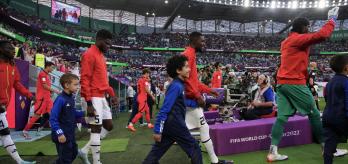Key observations
-
Ligue 1 and the EPL developed most of the African players at this World Cup, and only a limited number of African professional leagues are developing World Cup players. We can conclude that there is a fundamental imbalance in the talent development eco-system when it comes to where players make the transition to the senior game around the world.
-
The recently launched FIFA Clearing House will ensure the 427 training clubs involved are rewarded by means of training compensation and solidarity contribution payments. This mechanism is an important step towards the promotion of financial transparency and integrity in the training and development of young players.
Definition
For a club to have "trained" a player at the World Cup, that player must have been with the club for at least three years between the seasons of their 15th and 21st birthdays. According to this definition, 4.4% of players at the World Cup did not have a "training club", 91.5% had one training club and 4.1% had two training clubs. The last of these categories may be small, but it notably includes Cristiano Ronaldo, who spent four seasons at Sporting CP between the ages of 15 and 18, and three at Manchester United FC between the ages of 19 and 21.
Breakdown of training clubs
In total, the 830 players selected to play at FIFA World Cup 2022 were trained by 427 clubs. The club responsible for training most players at this World Cup is AFC Ajax, with 11 of its graduates representing five different teams in Qatar. Whereas we saw that large contingents of World Cup players currently play at a handful of senior professional clubs, concentrations of players at individual clubs appears less marked when we consider where they were trained as youngsters. The top ten training clubs between them trained 9.9% of the players selected for the tournament (while 16.5% of players currently play for the top ten employers). This percentage rises 18.0% for the top twenty training clubs (as opposed to 28.0% for the top twenty current employers) and 34.3% for the top fifty (as opposed to 48.9%).
Location of training clubs
Of the 427 clubs who can claim to have trained at least one player at the 2022 World Cup between their 15th and 21st birthdays, most of them are in UEFA member associations. The highest number of training clubs was recorded in France (31), closely followed by England (30). These figures reflect the number of players who move to these two countries as youngsters and go on to represent other national teams. They are also a product of the way training in these two countries is organised as a fully-fledged development pathway, with many clubs having their own internal systems designed to nurture elite players.
Training clubs of the younger generation
If we split the 830 players into two groups either side of the median age for players at this tournament (27.3 years), and create separate rankings for each group, we find that the lists are very different. Ecuador's Independiente del Valle has trained more players under the age of 27.3 than anyone else, while Costa Rica's Deportivo Saprissa heads the ranking for older players.
We see that the elder half of the players at the FIFA World Cup trained at a wider spread of clubs than their younger counterparts. The top ten training clubs trained 12.1% of the older players in the 32 squads, as opposed to 13.3% for the younger ones. If we expand the list to the top 20 clubs, this percentage rises to 19.6% (as opposed to 23.0%), and the top fifty clubs account for 36.0% of the elder players, as against 41.9% for the younger ones. The fact the younger players are concentrated at fewer clubs is a striking reflection of the way dominant teams within national associations are tending to integrate the best domestic and foreign talent into their youth teams at ever earlier ages.
Training countries
When it comes to the individual countries in which the players were trained, two stand out: England (73 players) and France (65 players). Clubs from both of these national associations have trained large numbers of players not just for "their" own national sides, but for a number of the other teams represented in Qatar. For English clubs, the number of players representing Wales (17 players) and Poland (4) stands out, whereas French clubs have trained major contingents of players for Cameroon (11), Senegal (10) and Tunisia (8).
Of the players representing a different country to the one they trained in, half are the sons of migrants who have chosen to represent the nation where one of their parents was born. The other players in this category generally left their home countries at a very young age when they were recruited by a foreign club. Denmark's Christian Eriksen, who left his homeland for The Netherlands at the age of 16, is a notable example.
In total, the players selected to play at FIFA World Cup 2022 spent at least three seasons between the ages of 15 and 21 attached to clubs from 39 national associations; the 32 that will be in Qatar and 7 others. Of those seven countries, Scotland and Italy trained most players, with four each.











